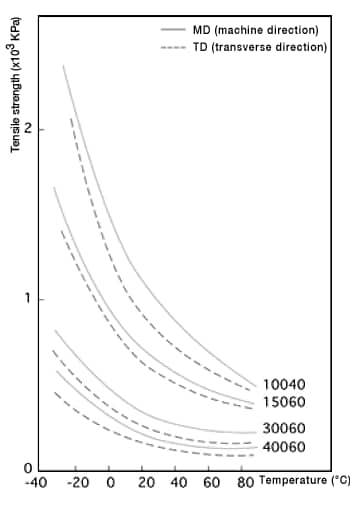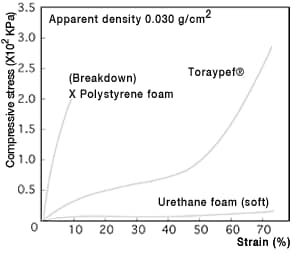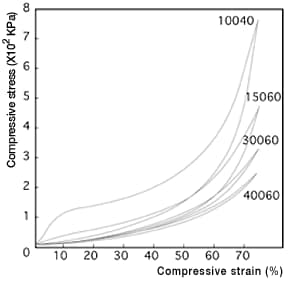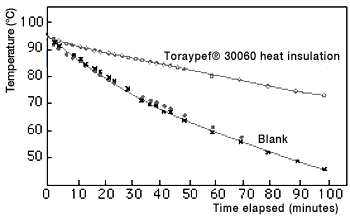- HOME
- Technical Information
- TORAYPEF™ Polyolefin Foam
- Excellent cushioning
Excellent cushioning
TORAYPEF™ comprises foam cell walls in a closed-cell microstructure made of polyolefin foam that contains 89-97% air by volume. This structure and composition makes TORAYPEF™ lightweight and sturdy and provides superb chemical and electrical properties. See the Table of General Properties of Major TORAYPEF™ Grades for more information.
Foam structure
The properties of plastic foam—in particular, compressive, water-absorption, water-permeability and sound-absorption properties—hinge upon whether the foam has an open-cell or closed-cell structure. Leveraging Toray’s proprietary process, we have succeeded in obtaining a nearly 100% closed-cell foam structure in each grade of TORAYPEF™ that allows absolutely no water permeation. These characteristics can be attributed to the extremely high degree of heat-insulation and buoyancy achieved by TORAYPEF™.
Mechanical properties
Ⅰ. Tensile properties
At a broad range of temperatures up to about 80°C, TORAYPEF™ exhibits enough tensile strength and viscosity to withstand practical applications. Figure 1 shows the relationship between tensile strength and temperature.

Figure 1: Relationship between tensile strength and temperature
Ⅱ. Compressive properties
Stress-strain curve
Figure 2 shows the stress-strain curve under compression. As you can see, a higher expansion ratio leads to smaller hysteresis loss and greater elasticity. Figure 3 compares the compressive stress-strain curve of TORAYPEF™ to representative examples of rigid and soft foams. TORAYPEF™ exhibits qualities that fall in between the two types of foam—in essence, TORAYPEF™ could be considered a semi-rigid foam.
 Figure 2: Compressive stress-strain curve
Figure 2: Compressive stress-strain curve Figure 3: Stress-strain curve of representative types of foam
Figure 3: Stress-strain curve of representative types of foam
Ⅲ. Compressive hardness
Compressive hardness is expressed as the compressive stress value after 20 seconds at 25% compression. Figure 4 shows the relationship between compressive hardness and temperature. As you can see, compressive hardness increases at lower temperatures, as is the case with general plastics; however, that increase is merely slight in a highly expanded product.

Dimensions measured after leaving samples in a standard state for one hour after heating at 80°C.
For the -20°C temperature, dimensions were measured in a low-temperature chamber.
Figure 4: Relationship between compressive hardness and temperature
※These data are representative examples of measurement values obtained using specific conditions. The values should not be used as a standard.